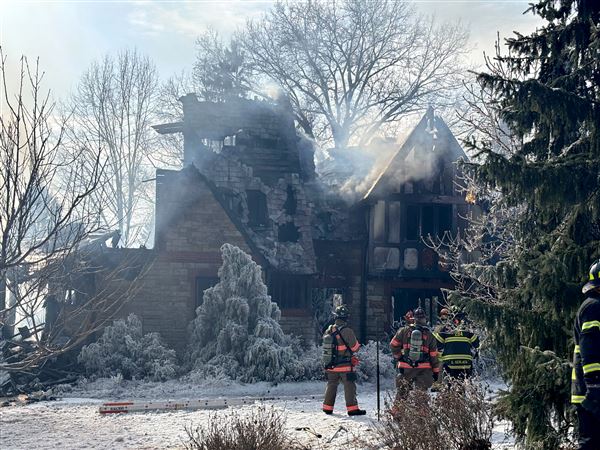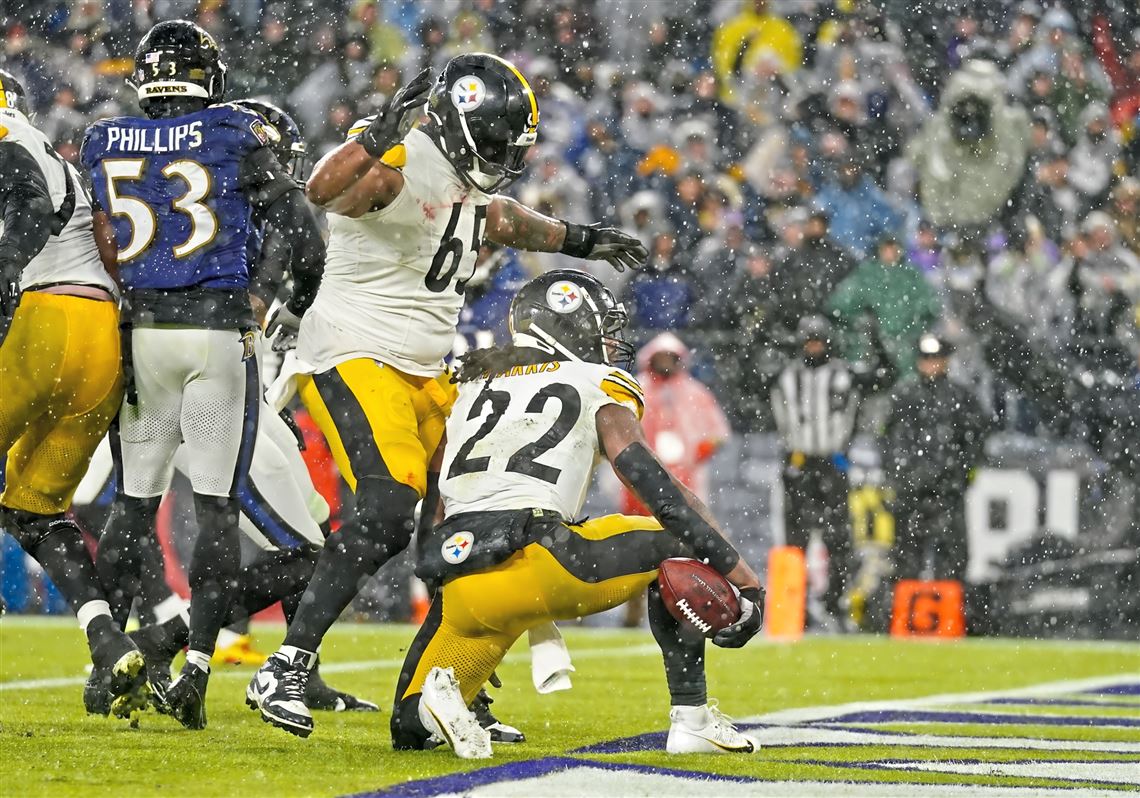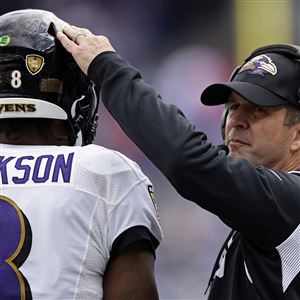If the Steelers are to pull off an upset against the Bills on Sunday, it will require the biggest strength of the offense that’s developed this season — the ability to run the ball and dominate the line of scrimmage.
Weather reports indicate wind gusts could range between 30-60 mph throughout Sunday in Buffalo, N.Y., and combined with accumulating snow, the conditions could make it difficult for either team to efficiently throw the football. That’s where the old-school, power-running Steelers football that’s made a resurgence this season can carry the team in a playoff game.
In the Steelers’ last 10 games, the offense has averaged 145.2 rushing yards per game, which would rank second in the NFL if they kept that pace the entire season. It’s become a consistent feature of the team behind Najee Harris’ 1,035 rushing yards on 255 carries and Jaylen Warren’s 784 rushing yards on 149 carries. That one-two running back punch led the Steelers’ rushing attack to average 118.2 yards per game, 13th-best in the NFL.
Even at that mark, it’s the highest a Steelers rushing attack has ranked at a season’s end since it finished 11th back in the 2010-2011 season, the last time a Steelers team made the Super Bowl.
But for Harris and Warren to be highlight features for the Steelers, their offensive line has to dominate.
One key element the Steelers’ offensive line has made consistent is their ability to get to the second level of the defense and block linebackers. Plenty of Harris’ runs during the first seven games of the season — and two previous years — were stymied by charging linebackers who clogged running lanes. Without that consistent presence, the Steelers’ run game has flourished.
Against the Ravens on Sunday, the Steelers had several instances when their linemen got to Baltimore’s linebackers. During their first scoring drive in the first quarter, one Harris 9-yard rush was keyed by right guard James Daniels pulling to the left side of the line with tight end Darnell Washington sealing off the left edge rusher. Daniels’ pull led to him blocking linebacker Patrick Queen, while Washington’s seal on the edge allowed left tackle Dan Moore Jr. to climb to Mike linebacker Del’Shawn Phillips.
Those three blocks were the essential element to the gain.
The Steelers have developed a brand of offensive line play that involves core plays recognizable across multiple games.
Those plays are a mix of run concepts that make it easier for specific linemen — usually the tackles in Moore or Broderick Jones — to climb to the second level and block linebackers at the point of attack. During the Steelers’ first seven games, those plays occurred but weren’t staples to the offense. Now, they’re consistent factors that open holes almost every week.
“It’s just schematics,” Steelers head coach Mike Tomlin said during his Tuesday press conference when asked about the developed run concepts. “We’ve got things we do. What we choose to do week-in and week-out is dependent on the matchup. Whether that’s the schematic component of the matchup, or the personnel component of the matchup, that’s what we’re doing on the [early portion] of weeks like this. We decide within our arsenal what we choose to highlight based on those variables. That’s the process for us, and we’ve had the opportunity in recent weeks to do some of [those] things.”
The Steelers’ guards — Isaac Seumalo and Daniels — are elemental to getting the tackles to the second level. During the Steelers’ second touchdown drive against the Bengals on Dec. 23, a similar run concept opened up a hole that Harris used to gain 13 yards. Seumalo pulled to seal Bengals edge rusher Trey Hendrickson, while Daniels pulled to seal defensive tackle Cam Sample, who was lined up in front of Seumalo.
Those two blocks wiped out the left side of the Bengals’ defensive line and allowed Pat Freiermuth to block safety Jordan Battle and Moore to easily seal off linebacker Germaine Pratt to complete the opening for Harris.
Harris’ role as the Steelers’ leader in scrimmage yards with 1,205 means the offense has tailored around his abilities as a power back. Those abilities get amplified late in the season, when Harris’ powerful running style can wear down opponents at the end of a long season and become even more important in colder, harsher weather conditions.
“He’s a big back,” Tomlin said of Harris. “We value big backs here in Pittsburgh. The attrition component that [comes with] the season, and the weather component, it just tees [games] up for guys with skill sets like his.”
If Harris is to use his skill set, it will require the Steelers’ offensive line to use more of the schematics Tomlin mentioned. Seumalo also features as a strong pulling blocker, and he did so especially on Harris’ first-quarter touchdown against the Ravens on Sunday. On the touchdown run, Seumalo pulled down the line to pancake defensive tackle Justin Madubuike, who was lined up in front of Jones.
Add in another pulling block from Daniels to the right side, and that led to Moore and Jones each getting the clean looks to block the Ravens’ linebackers and paved the way for Harris’ touchdown.
If you look back at Harris’ touchdown, you can see the Ravens’ linebacker, Queen, start to follow Daniels’ pull to the right, setting him up to be blocked by Jones. That’s where creative run concepts can come into play to influence linebackers and create more rushing lanes.
But to be a good offensive line in today’s NFL, you need other linemen who can pull and block in space. That’s a key feature that Jones brings from his athletic pedigree at Georgia.
As far back as the Steelers’ game against Browns on Nov. 19, Jones’ ability to pull and block effectively became a staple for the Steelers’ rushing attack. During the second quarter of that game against the Browns, Harris gained 9 yards behind a play where Jones pulled from the right side of the line to block the weak-side Browns linebacker, Sione Takitaki. While his athleticism is impressive in that moment, it’s also created by strong seal blocks from Seumalo and More on the left side to create space for both Jones to charge into the hole and Harris to follow.
And on that play, the Browns’ linebackers had to hold their positions and weren’t sure of where to attack because they were looking for the Steelers’ guards to pull, not Jones.
To add wrinkles to the Steelers’ run game, their tight ends have also gotten involved in pulling across the line for wham blocks at key points to free up Jones and Moore to get to linebackers. Against the Ravens, the Steelers deployed that concept several times with success. During the third quarter, Harris reeled off a 15-yard run behind one of those plays as tight end Connor Heyward pulled down the line to take on Ravens outside linebacker Tavius Robinson.
That block freed up Jones to get a clean block on safety Geno Stone, who came down in the formation as a dime linebacker. Harris rushed between Jones and Heyward, and his built-up steam made for his longest run of the game.
As Tomlin indicated during his press conference, the Steelers have to study the Bills’ defense to see what the best methods will be for getting its offensive line to the second level of Buffalo’s defense. These are now plays that have become the bread and butter of the Steelers’ offense, and they’ve developed a variety of methods to accomplish them.
If those concepts are executed with consistency in Sunday’s playoff game, it could be the key the Steelers need to control the pace and make their style of football the story of the game.
Christopher Carter: ccarter@post-gazette.com and on Twitter @CarterCritiques
First Published: January 10, 2024, 10:30 a.m.
Updated: January 10, 2024, 3:40 p.m.





























